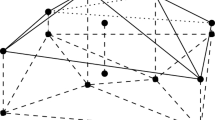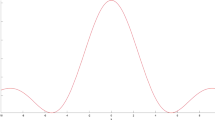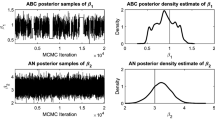Abstract
Quasi-random sequences are known to give efficient numerical integration rules in many Bayesian statistical problems where the posterior distribution can be transformed into periodic functions on then-dimensional hypercube. From this idea we develop a quasi-random approach to the generation of resamples used for Monte Carlo approximations to bootstrap estimates of bias, variance and distribution functions. We demonstrate a major difference between quasi-random bootstrap resamples, which are generated by deterministic algorithms and have no true randomness, and the usual pseudo-random bootstrap resamples generated by the classical bootstrap approach. Various quasi-random approaches are considered and are shown via a simulation study to result in approximants that are competitive in terms of efficiency when compared with other bootstrap Monte Carlo procedures such as balanced and antithetic resampling.
Similar content being viewed by others
References
Corput, J. G. Van der (1935) Verteilungfunktionen.Nederl. Akad. Wetensch. Proc. 38, 813–821.
Davis, P. J. (1963)Interpolation and Approximation, Ginn (Blaisdell), Boston, Mass.
Davis, P. J. and Rabinowitz, P. (1984)Methods of Numerical Integration (2nd edn), Academic Press, Orlando, Fla.
Davison, A. C. (1988) Contribution to discussion.J. R. Statist. Soc. B,50, 356–357.
Davison, A. C., Hinkley, D. V. and Schechtman, E. (1986) Efficient bootstrap simulation.Biometrika,73, 555–566.
Efron, B. (1990) More efficient bootstrap computations.J. Amer. Statist. Assoc.,85, 79–89.
Graham, R. L., Hinkley, D. V., John, P. W. M. and Shi, S. (1990) Balanced design of bootstrap simulations.J. R. Statist. Soc. B,52, 185–202.
Haber, S. (1966) A modified Monte Carlo quadrature.Math. Comp.,20, 361–368.
Hall, P. (1989) Antithetic resampling for the bootstrap.Biometrika,76, 713–724.
Halton, J. H. (1960) On the efficiency of certain quasi-random sequences of points in evaluating multi-dimensional integrals.Numer. Math.,2, 84–90.
Hammersley, J. M. (1960) Monte Carlo methods for solving multivariate problems.Ann. New York Acad. Sci.,86, 844–874.
Hlawka, E. (1961) Funktionen von beschränkter Variation in der Theorie der Gleichverteilung.Ann. Mat. Pura Appl.,54, 325–333.
Hlawka, E. (1962) Zur angenäherten Berechnung mehrfacher Integrale,Monatsh. Math.,66, 140–151.
Hua, L.-K. and Wang, Y. (1981)Applications of Number Theory to Numerical Analysis, Springer-Verlag, Berlin.
James, G. and James, R. C. (1976)Mathematics Dictionary (4th edn), Van Nostrand Reinhold, New York.
Johns, Jr, M. V. (1988) Importance resampling for bootstrap confidence intervals.J. Amer. Statist. Assoc.,85, 709–714.
Kennedy Jr., W. J. and Gentle, J. E. (1980)Statistical Computing, Marcel Dekker, New York.
Koksma, J. F. (1942) Een algemeene stelling mit de theorie der gelijkmatige verdeeling modulo 1.Mathematica B (Zutphen)11, 7–11.
Kuipers, J. F. and Niederreiter, H. (1974),Uniform Distribution of Sequences, Wiley, New York.
Lewis, P. A. W. and Orav, E. J. (1989)Simulation Methodology for Statisticians, Operations Analysts, and Engineers. Wadsworth & Brooks/Cole, Pacific Grove, California.
Martin-Löf, P. (1969) Algorithms and randomness.Review of the Int. Statist. Inst.,37, 265–272.
Niederreiter, H. (1977) Pseudo-random numbers and optimal coefficients.Adv. Math.,26, 99–181.
Niederreiter, H. (1978) Quasi-Monte Carlo methods and pseudo-random numbers.Bull. Amer. Math. Soc. 84, 957–1042.
Niederreiter, H. (1987) Pointer sets and sequences with small discrepancy.Monatsh. Math.,104, 273–337.
Ogbonmwan, S. M. and Wynn, H. P. (1986) Accelerated resampling codes with low discrepancy. Unpublished paper, Department of Statistics, Imperial College, London.
Ripley, B. D. (1987)Stochastic Simulation. J. Wiley and Sons, New York.
Shaw, J. E. H. (1988) A quasi-random approach to integration in Bayesian statistics.Ann. Statist.,16, 895–914.
Smith, A. F. M., Skene, A. M., Shaw, J. E. H.et al. (1985) The implementation of the Bayesian paradigm.Comm. Statist. A—Theory & Methods,14, 1079–1102.
Warnock, J. T. (1972) Computational investigations of low-discrepancy point sets, inApplications of Number Theory to Numerical Analysis, Zaremba, S. K. (ed), Academic Press, New York, pp. 319–343.
Zaremba, S. K. (1966) Good lattice points, discrepancy, and numerical integration.Ann. Mat. Pura Appl.,73, 293–317.
Zaremba, S. K. (1968) The mathematical basis of Monte Carlo and quasi-Monte Carlo methods.SIAM Rev.,10, 303–314.
Author information
Authors and Affiliations
Rights and permissions
About this article
Cite this article
Do, KA., Hall, P. Quasi-random resampling for the bootstrap. Stat Comput 1, 13–22 (1991). https://doi.org/10.1007/BF01890833
Received:
Accepted:
Issue Date:
DOI: https://doi.org/10.1007/BF01890833




